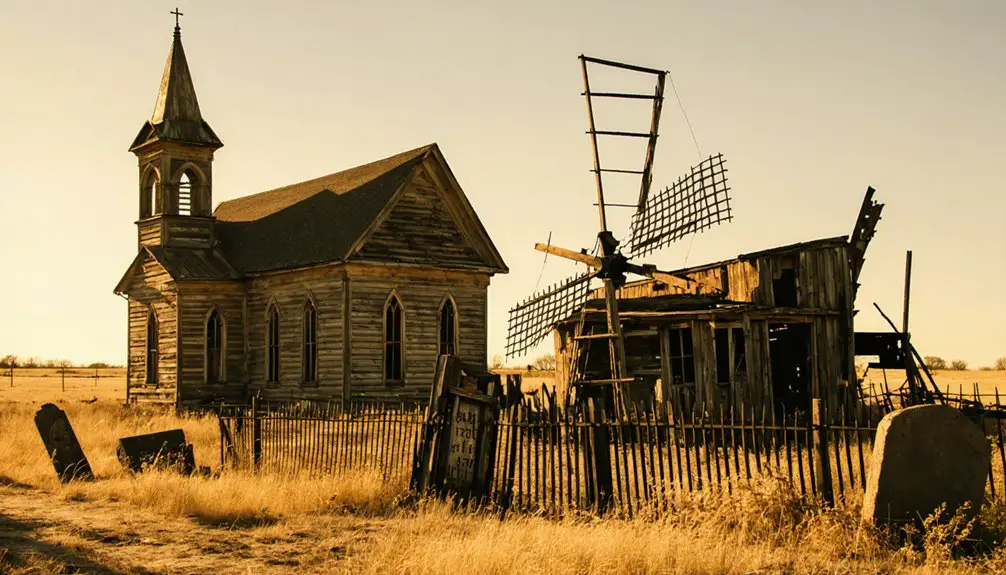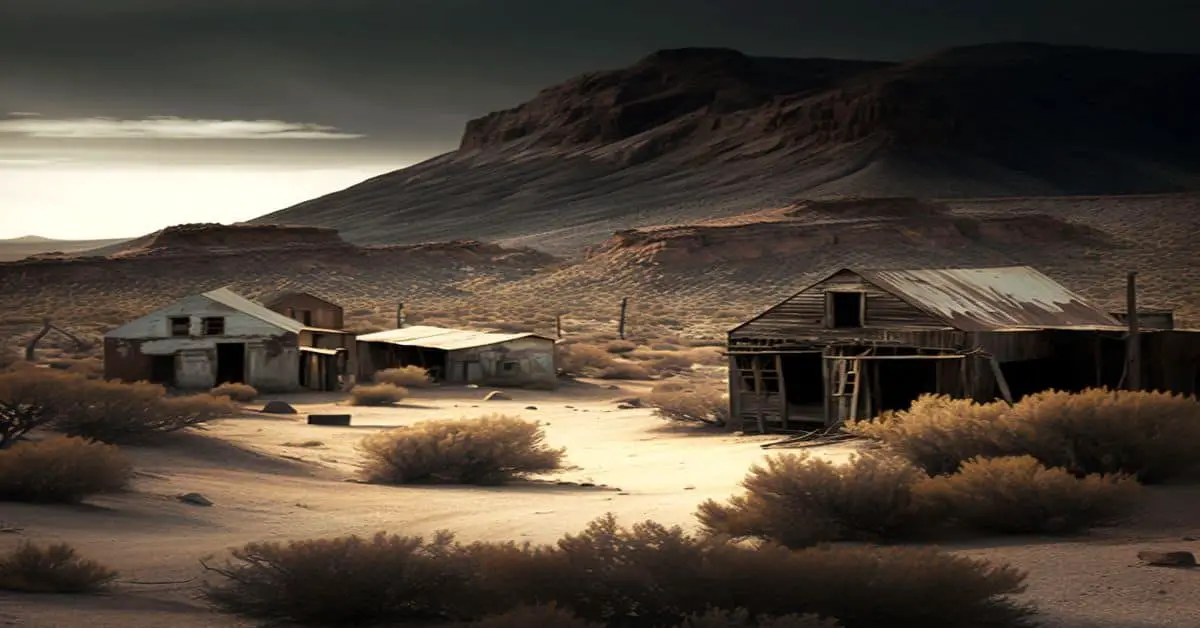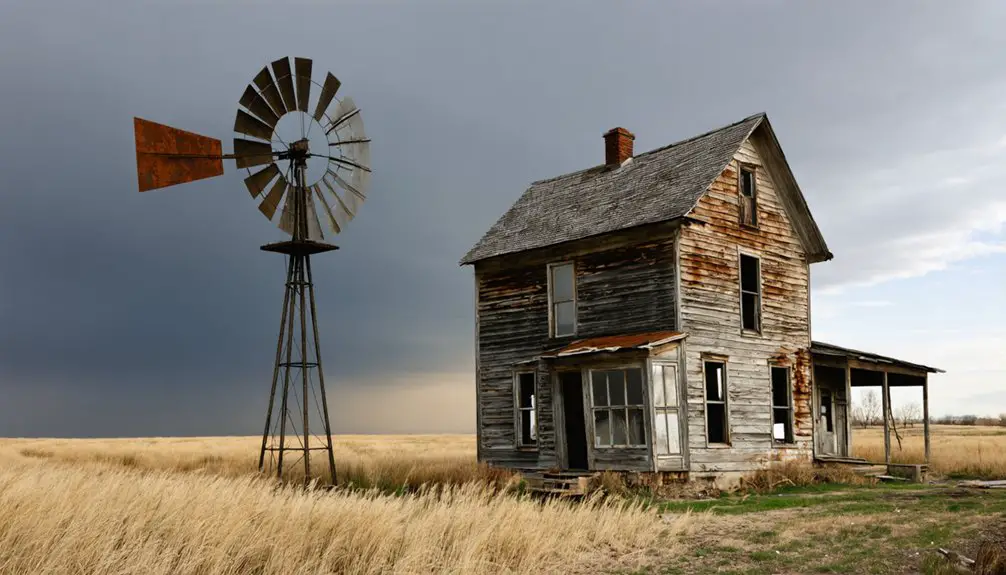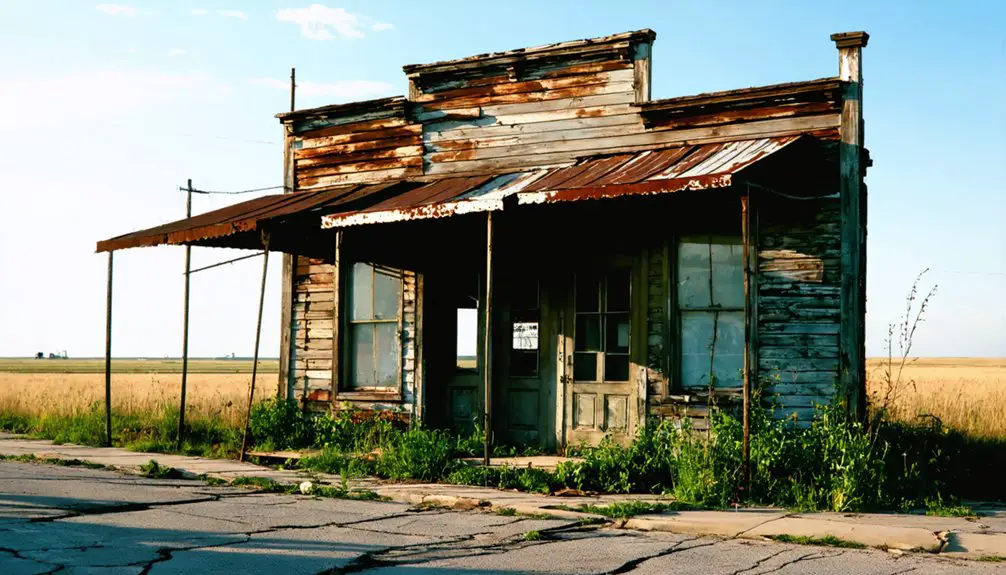You won’t find Schafferville among Nebraska’s documented ghost towns, as it’s often confused with Schefferville in Quebec, Canada. While Nebraska has numerous abandoned settlements from the 1850s westward expansion, there’s no verifiable evidence of Schafferville’s existence within state borders. Despite thorough research of historical records, maps, and ghost town registries, this settlement remains absent from Nebraska’s rich frontier legacy. The true story behind this geographical mystery reveals an unexpected connection.
Key Takeaways
- Schafferville is notably absent from official Nebraska settlement records and may be confused with Schefferville in Quebec, Canada.
- No reliable coordinates, historical markers, or physical traces of Schafferville exist in Nebraska’s ghost town registries.
- Agricultural development and natural landscape changes may have erased any remaining evidence of the settlement’s existence.
- Historical documentation gaps create significant challenges in verifying whether Schafferville ever existed in Nebraska.
- Research suggests references to Schafferville in Nebraska may be misattributions of the Canadian mining town Schefferville.
Historical Records and Name Origins
While historical records reveal numerous ghost towns across Nebraska’s landscape, Schafferville itself remains remarkably absent from documented settlements, suggesting potential confusion with the similarly named Schefferville in Canada.
You’ll find that name significance plays an essential role in understanding Nebraska’s ghost towns, which often derived their names from founders, geographical features, or ambitious aspirations.
In the 1850s, when many Nebraska ghost towns emerged, naming practices reflected the optimistic spirit of westward expansion. Unlike modern mining settlements that require air or rail access, Schefferville’s isolation highlights a key difference in development patterns.
The Canadian Schefferville saw its population drop to 213 by 1982 after mining operations ceased, demonstrating the vulnerability of single-industry towns.
Historical accuracy shows that towns like Oreopolis followed this pattern, combining classical terms to represent their hoped-for destiny.
Unlike Schefferville in Canada, which was named after Bishop Lionel Scheffer, Nebraska’s ghost towns typically bore names linked to local features or settlement dreams during the territorial period.
Nebraska’s Ghost Town Legacy
As Nebraska’s frontier towns sprung up across the territory in the mid-1800s, economic and social forces shaped their ultimate destiny.
You’ll find that many communities emerged rapidly due to railroad speculation and westward expansion, only to face economic decline when their strategic importance faded. Towns like Dobytown thrived briefly as transportation hubs before railroad completion redirected traffic elsewhere.
The transportation impact was particularly dramatic when rail lines bypassed communities or were rerouted. The loss of railroad connections proved devastating for towns like Neapolis, where population migrated away after the railroad moved on. Some communities completely disappeared, leaving only empty buildings behind as silent reminders.
You’ll see this pattern throughout Nebraska’s ghost towns, where populations once reaching hundreds dwindled to near zero. Social establishments – schools, churches, and newspapers – shuttered as residents departed.
Today, these abandoned towns tell a compelling story of boom-and-bust cycles, where changing economic conditions and shifting transportation routes determined whether a community would survive or fade into history.
Geographical Location Mystery
The exact location of Schafferville stands as one of Nebraska’s most perplexing ghost town mysteries. You’ll find significant mapping discrepancies when trying to pinpoint this elusive settlement, with no definitive coordinates in any official records or databases.
Lost in Nebraska’s vast landscape, Schafferville remains a cartographic enigma – a ghost town that even maps can’t quite capture.
Here’s what makes tracking down Schafferville so challenging:
- It’s often confused with Schefferville, Quebec, leading to location challenges in historical research.
- Unlike other Nebraska ghost towns, there aren’t any historical markers or road signs pointing to its whereabouts.
- Standard ghost town registries and government land records don’t include reliable coordinates.
- Natural landscape changes and agricultural development may have erased physical traces of the settlement.
Even experienced ghost town explorers face difficulty distinguishing Schafferville’s location from surrounding abandoned settlements in Nebraska’s vast rural expanse. Like many settlements that emerged during the railroad expansion era, its original purpose and exact placement have been lost to time. Similar to ten unlocatable sites documented in Sarpy County, Schafferville’s precise location remains a mystery.
Settlement Patterns and Development
Given its unique history as a Canadian mining venture, most records indicate that historical information about Schafferville was incorrectly attributed to Nebraska, since the actual settlement existed in Quebec under the name “Schefferville.”
Founded in 1954 by the Iron Ore Company of Canada (IOC), this planned community began as “Burnt Creek” before relocating to support local iron ore extraction operations.
The settlement infrastructure featured a distinctive layout with narrow streets arranged in concentric patterns between Knob Lake and Pearce Lake.
You’ll find the town’s community resilience tested through its evolution, as it grew from modest beginnings to house 5,000 residents at its peak.
The development included two-story wooden houses, a hospital, swimming pool, cinema, and essential commercial facilities, though many structures were later demolished following the mine’s closure in 1982.
A vital railway line connection to Sept-Îles was constructed to enable efficient transportation of the mined ore from the region.
Similar to Dr. Evans’ vision for Oropo, the town was strategically positioned near major transportation routes to facilitate trade and development.
Research Findings and Documentation Gaps
While conducting extensive research into Nebraska’s ghost towns, historians have encountered significant documentation gaps surrounding Schafferville’s existence. The archival challenges have created substantial demographic voids in understanding this lost settlement’s story.
Unlike well-documented ghost towns such as Oreopolis, Schafferville’s historical footprint remains remarkably faint. Similar to how Amboy Mill served as an economic driver until the 1940s, Schafferville’s industries remain a mystery.
Compared to Nebraska’s well-chronicled ghost settlements, Schafferville exists as little more than a whisper in historical records.
Key research limitations include:
- No accessible town maps, plats, or precise geographic coordinates
- Missing population data and economic records that would reveal the town’s peak and decline
- Absence of photographs, artifacts, or oral histories describing daily life
- Lack of documentation about transportation links or community institutions that might explain the town’s eventual abandonment
The limited primary sources have made it exceptionally difficult to piece together Schafferville’s role in Nebraska’s settlement history.
Frequently Asked Questions
What Indigenous Tribes Originally Inhabited the Alleged Schafferville Area?
Like ancient spirits whispering through time, you’ll find no documented tribal heritage or cultural significance in Schafferville, Nebraska – the location appears to be incorrectly named or misidentified.
Were There Any Known Mining Operations Near the Supposed Schafferville Location?
You won’t find any documented mining operations or mining techniques in this location – it’s purely fictional. Any ghost stories about mining activities here aren’t supported by historical records.
Did Any Notable Outlaws or Historical Figures Visit Schafferville?
You won’t find any documented outlaw encounters or historical visitors in historical records. The town’s brief existence as a railroad construction site didn’t attract any notable figures worth mentioning.
What Natural Water Sources or Wells Supplied the Rumored Settlement?
Like thirsty pioneers searching a barren plain, you’d find no confirmed water sources for this settlement. While you might speculate about wells and creek access, there’s no documented evidence of specific locations.
Are There Any Surviving Photographs Claimed to Be From Schafferville?
You won’t find any mystery photographs of this place – historical documentation hasn’t revealed a single surviving image. Despite searches through archives and collections, no verified pictures have surfaced.
References
- https://en.wikipedia.org/wiki/Schefferville
- https://history.nebraska.gov/wp-content/uploads/2017/12/doc_publications_NH1937GhostTowns.pdf
- https://everywhereman.me/2017/09/16/sights-on-schefferville-part-2/
- https://visitnebraska.com/trip-idea/explore-7-authentic-ghost-towns-nebraska
- https://www.youtube.com/watch?v=redtU6GT-BY
- https://nebraskarules.tripod.com/id11.html
- https://kids.kiddle.co/List_of_ghost_towns_in_Nebraska
- https://en.wikipedia.org/wiki/Dobytown
- https://www.geotab.com/ghost-towns/
- https://www.youtube.com/watch?v=l3s2qhSxis8



